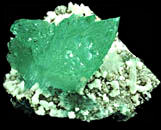|
|
| Formula: | KCa4 (Si4O10)2F•8H2O | 
Click to see a larger image |
||
| Crystal: | Tetragonal | |||
| Hardness: | 4.5-5 | |||
| Spec. Gr.: | 2.33-2.37 | |||
| Streak: | N/A | |||
| Cleavage: | Perfect basal | |||
| Location: | Poona, India |
| Apophyllite is a close relative and frequently associates with zeolite minerals. Like zeolite, it forms in layers of rapidly cooling basalt called traprock. As basalt cools, gas bubbles form and then leave cavities which accept surface waters percolating downward along creeks and fissures. These waters bring sodium, calcium, potassium, aluminum and silica and form zeolite and apophyllite crystals. Apophyllite in large (six inches on an edge) pale green crystals that are tetragonal, but appear cubic, are found in the states of Rio Grande do Sul and Bahia, Brazil; Paterson, New Jersey; and at quarries near Poona, India. The Khadakvasla quarry (Poona) has provided large numbers of emerald-green apophyllite crystal groups associated with heulandite. |
|
Bibliography: Hurlbut, Cornelius, Minerals and Man, 1970, pg. 92-102. |
|
University of California, Santa Barbara—Department of Earth Science Copyright © 2005 Regents of the University of California Send your comments to the Web Page Editor |